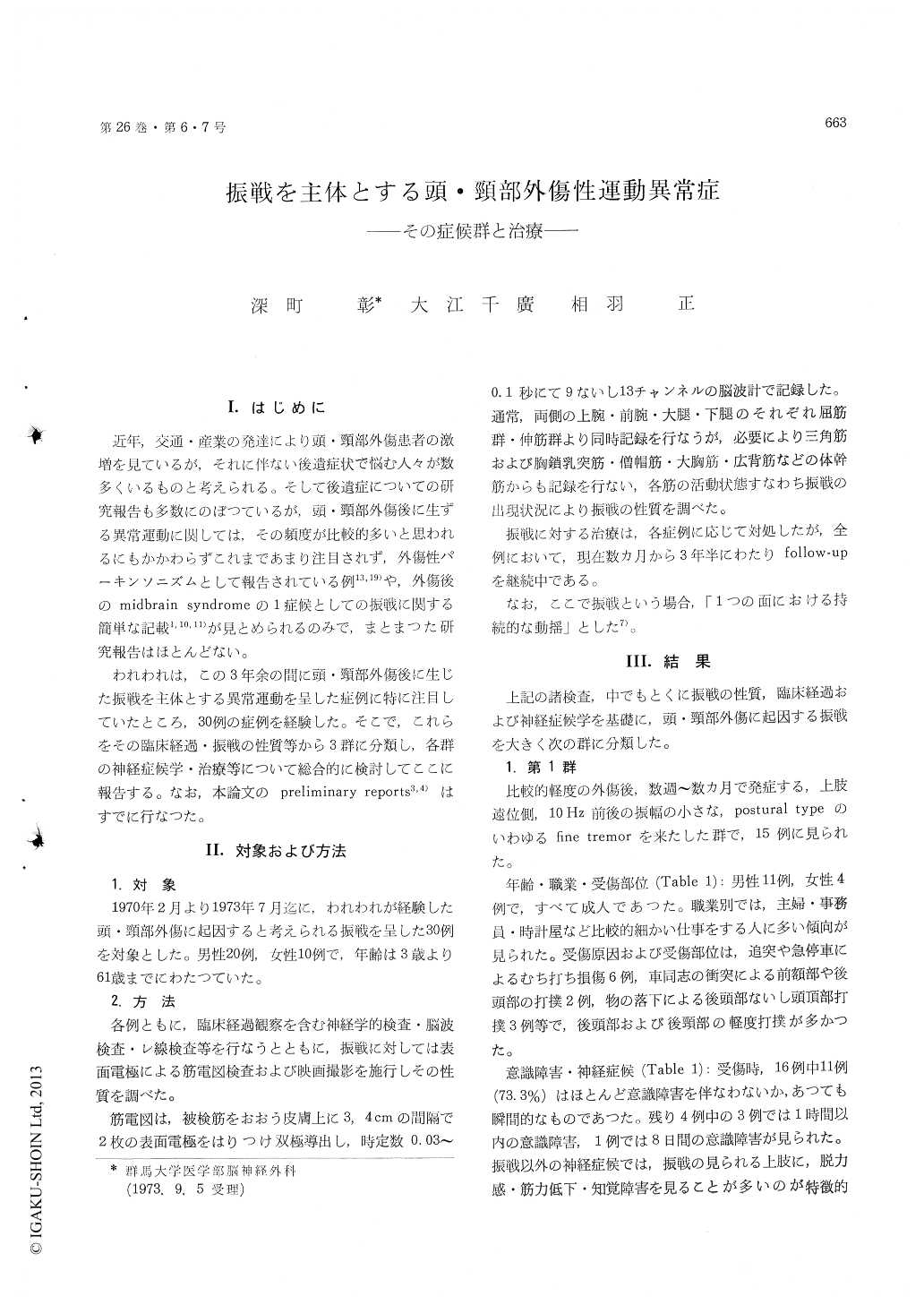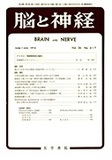Japanese
English
- 有料閲覧
- Abstract 文献概要
- 1ページ目 Look Inside
I.はじめに
近年,交通・産業の発達により頭・頸部外傷患者の激増を見ているが,それに伴ない後遺症状で悩む人々が数多くいるものと考えられる。そして後遺症についての研究報告も多数にのぼっているが,頭・頸部外傷後に生ずる異常運動に関しては,その頻度が比較的多いと思われるにもかかわらずこれまであまり注目されず,外傷性パーキンソニズムとして報告されている例13,19)や,外傷後のmidbrain syndromeの1症候としての振戦に関する簡単な記載1,10,11)が見とめられるのみで,まとまった研究報告はほとんどない。
われわれは,この3年余の間に頭・頸部外傷後に生じた振戦を主体とする異常運動を呈した症例に特に注目していたところ,30例の症例を経験した。そこで,これらをその臨床経過・振戦の性質等から3群に分類し,各群の神経症候学・治療等について総合的に検討してここに報告する。なお,本論文のpreliminary reports3,4)はすでに行なった。
In recent three years, we have experienced thirty cases of abnormal movement with various types of tremor, which was thought to be induced by head injury. According to their clinical courses, the natures of tremor and another symptoms and signs, they were classified into three major groups. It is the purpose of this paper to describe the semi-ological details of each group and the results of of treatments for these tremors.
1) In the first group (15 adult cases), most of the cases had slight injuries to occipital or nuchal region without loss of consciousness. They had the fine tremor of postural type, which appeared in the distal parts of mostly unilateral upper limb, such as hand and fingers, several weeks or months after the minor injuries. In the same upper limb, weakness was seen in 10 cases and disturbance of sensation in 4.
This kind of tremor was, therefore, thought to be an accentuated physiological tremor. Fourteen cases were treated with antiparkinsonian drugs such as trihexyphenidyl and amantadine hydroch-loride and/or minor tranquilizer (diazepam). Seven of them showed slight improvement of the tremor.
2) Second group contained 7 infants under 10 years, one 17-year old boy and 3 adults. All of them met with severe head injuries with long periods of disturbance of consciousness. With the improvement of consciousness and pareses of limbs, the coarse tremor of 3-4 Hz appeared mainly in the proximal portion of upper extremity and oc-casionally in the trunk muscles. Nine cases showed unilateral tremor and the others bilateral. Accord-ing to the muscular activities, under which the tremor was manifested, these coarse tremors were further classified into two types; resting~postural and intentional one. The former was seen in two of three adults and the latter in one adult case and six infants under 10 years. Another two patients revealed different types of tremor in dif-ferent parts of the body.
From symptomatology (Table 2) referring to several literatures on tremor by a lesion in mid-brain, these coarse tremors were considered to be also due to midbrain damages.
All infants under 10 years were followed up without any medications for tremor, and it was clarified that their tremors subsided considerably. On the contrary, in adult cases no improvements were found after medications of some antiparkinso-nian drugs. The stereotaxic sub-Vim thalamotomy was performed in these adult patients with ex-cellent results.
3) In the third group four adults over 40 years of age suffered from such minor head injuries as in the first group. The coarse tremor resembling to that of the second group developed thereafter. Neurologically, all patients had headache and hemi-hypesthesia of superficial sensation on the tremor side without disturbances of cranial nerves except one case with transient diplopia. In two cases, the tremor appeared relatively suddenly, following attacks of severe headache. The appearance of tremors in this group might, therefore, be due not only to head injury itself, but also to another factors such as cerebrovascular disease.
The tremor was one of the major sequels after head injuries and was so distressing that we per-formed the sub-Vim thalamotomy for two patients with excellent results. The other are, now, treated with antiparkinsonian drugs, but only slight im-provement is obtained in one case.
Finally we proposed that these types of abnormal movements with tremor following head injuries could be a clinical entity as posttraumatic tremor, because of the similarity of signs and symptoms of individual cases in each group.

Copyright © 1974, Igaku-Shoin Ltd. All rights reserved.


